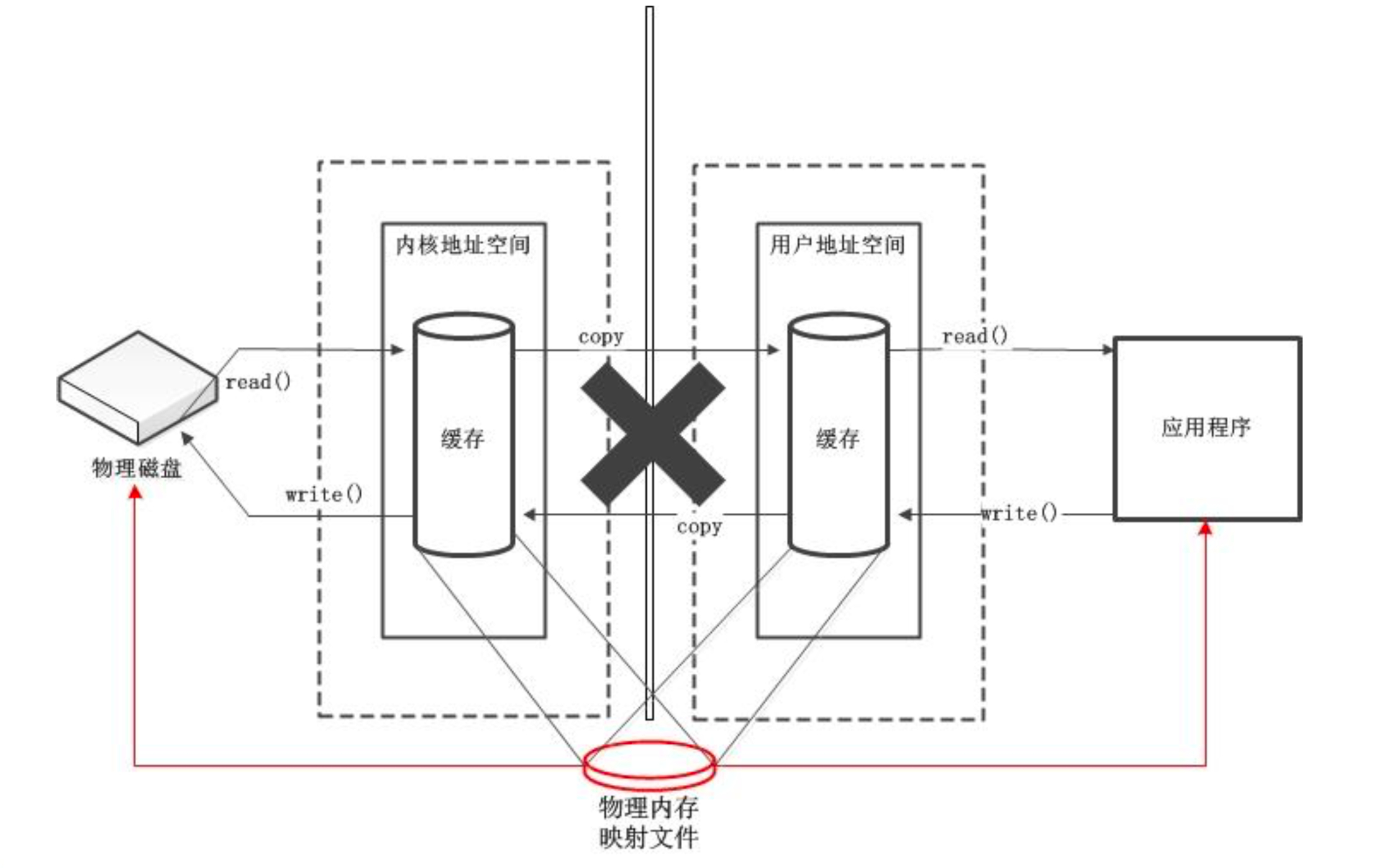介绍
在Java中,提供了一些关于使用IO的API,可以供开发者来读写外部数据和文件,我们称这些API为Java IO。IO是Java中比较重要的知识,而且比较难学习的知识点,随着Java的发展,目前提供了三种IO共存,分别是:BIO、NIO、AIO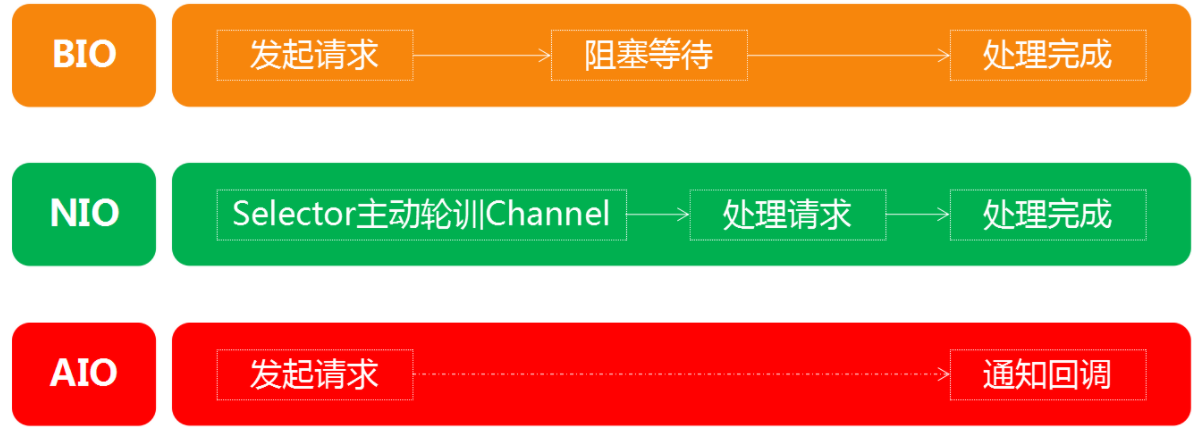
BIO
BIO全称Block-IO是一种同步且阻塞的通信模式,这种模式很简单,使用也方便。但缺点是并发处理能力低,通信耗时,依赖网速。
NIO
NIO 全称Non-Block IO,是Java SE 1.4版以后,针对网络传输效能优化的新功能,是一种非阻塞的同步通信模式。
NIO和IO有着同样的作用和目的,他们之间最重要的区别是数据打包和传输方式。I/O以流的方式处理数据,而NIO以块的方式处理数据。
面向流的I/O系统一次一个字节的处理数据,一个输入流产生一个字节数据,一个消费流消费一个字节数据。
而面NIO以面向块的形式处理数据,每一个操作都在一步中产生或者消费一个数据块。按块处理数据比按流(字节)处理数据要块的多。
AIO
AIO全称Asynchronous I/O,是异步非阻塞IO,是一个种非阻塞的异步通信模式,在NIO的基础上引入了异步通道的概念,并提供异步文件通道和异步套接字通道实现
NIO理论
NIO简介
Java NIO(New IO)是从Java 1.4版本开始引入的 一个新的IO API,可以替代标准的Java IO API。 NIO与原来的IO有同样的作用和目的,但是使用 的方式完全不同,NIO支持面向缓冲区的、基于 通道的IO操作。NIO将以更加高效的方式进行文 件的读写操作。
NIO和IO区别
| IO | NIO |
|---|---|
| 面向流(Stream Oriented) | 面向缓冲区(Buffer Oriented) |
| 阻塞IO(Blocking IO) | 非阻塞IO(Non Blocking IO) |
| (无) | 选择器(Selectors) |
通道和缓冲区
Java NIO系统的核心在于:通道(Channel)和缓冲区 (Buffer)。通道表示打开到 IO 设备(例如:文件、 套接字)的连接。若需要使用 NIO 系统,需要获取 用于连接 IO 设备的通道以及用于容纳数据的缓冲区。然后操作缓冲区,对数据进行处理。
简而言之,Channel 负责传输, Buffer 负责存储
缓冲区(Buffer)
- 缓冲区(Buffer):一个用于特定基本数据类型的容器。由 java.nio 包定义的,所有缓冲区都是 Buffer 抽象类的子类。
- Java NIO 中的 Buffer 主要用于与 NIO 通道进行交互,数据是从通道读入缓冲区,从缓冲区写 入通道中的。
Buffer 就像一个数组,可以保存多个相同类型的数据。根据数据类型不同(boolean 除外) ,有以下 Buffer 常用子类
ByteBufferCharBufferShortBufferIntBufferLongBufferFloatBufferDoubleBuffer
上述 Buffer 类 他们都采用相似的方法进行管理数据,只是各自管理的数据类型不同而已。都是通过如下方法获取一个 Buffer对象
以FloatBuffer为例,创建一个容量为 capacity 的 XxxBuffer 对象public static FloatBuffer allocate(int capacity)
缓冲区的基本属性
Buffer 中的重要概念
- 容量 (capacity) :表示 Buffer 最大数据容量,缓冲区容量不能为负,并且创建后不能更改。
- 限制 (limit):第一个不应该读取或写入的数据的索引,即位于 limit 后的数据不可读写。缓冲区的限制不能为负,并且不能大于其容量。
- 位置 (position):下一个要读取或写入的数据的索引。缓冲区的位置不能为负,并且不能大于其限制
- 标记 (mark)与重置 (reset):标记是一个索引,通过 Buffer 中的 mark() 方法 指定 Buffer 中一个特定的 position,之后可以通过调用 reset() 方法恢复到这 个 position.
标记、位置、限制、容量遵守以下不变式:0<=mark<=position<=limit<=capacity
示例:通过一个代码示例演示position、limit、capacity 三个值得变化
package com.javastack.netty;import java.io.FileInputStream;import java.io.FileNotFoundException;import java.nio.Buffer;import java.nio.ByteBuffer;import java.nio.channels.FileChannel;public class Test {public static void main(String[] args) throws Exception {// 这里用的是文件IOFileInputStream fis = new FileInputStream("D://test.txt");// 创建文件的操作管道FileChannel fc = fis.getChannel();// 分配一个10个大小的缓冲区,起始就是分配一个10个大小的Byte数组ByteBuffer buffer = ByteBuffer.allocate(10);output("初始化", buffer);// 先读以下fc.read(buffer, 5);output("调用read()", buffer);// 准备操作之前,先锁定操作范围buffer.flip();output("调用flip()", buffer);// 判断由没有可读数据while(buffer.remaining() > 0) {byte b = buffer.get();//System.out.println((char) b);}output("调用get()", buffer);// 可以理解为解锁output("调用clear()", buffer);// 最后把管道关闭fis.close();}/*** 打印缓冲区的实时状态* @param step* @param buffer*/public static void output(String step, Buffer buffer) {System.out.println(step + ":");// 容量、数组大小System.out.print("capacity:" + buffer.capacity() + ",");// 当前操作数据锁在位置,也可以叫作游标System.out.print("position:" + buffer.position() + ",");// 锁定值,flip,数据操作范围索引只能在position 到 limit 之间System.out.print("limit:" + buffer.limit());System.out.println();}}
输出结果如下:
通过运行结果进行图解分析,三个属性值的变化如下
- 初始状态,如下图所示:
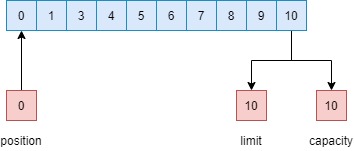
- 如果读取5个自己得数据,则此时position的值为5,既下一个将要被写入的字节索引为5,而limit依然是10,如下图所示:
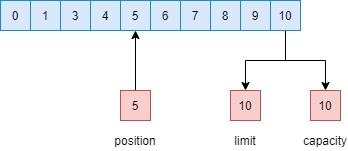
- 接着把读取的数据写入输出管道,相当于从缓冲区读取数据,在此之前,必须调用filp()方法。该方法将会完成以下两件事情:一是把limit设置为当前的position值,二是把position设置为0。由于position被设置为0,所以可以保证在下一步输出时读取的是缓冲区的第一个字节,而limit被设置为当前的position,可以保证读取的数据正好是之前写入缓冲区的数据,如下图所示:
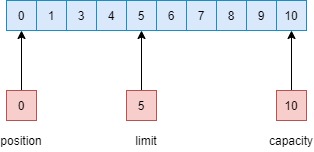
- 然后调用get()方法从缓冲区中读取数据写入输出通道,这会导致position的增加而limit保持不变,但position不会超过limit的值,所以在读取之前写入缓冲区的5个字节后,position和limit的值都为5,如下图所示:
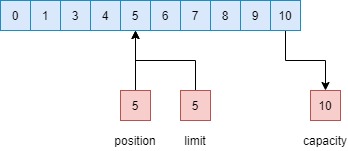
- 从缓冲区读取数据完毕后,limit的指任然保持在调用flip()方法时的值,调用clear()方法能够把所有的状态变化设置为初始化的值,如下图所示:
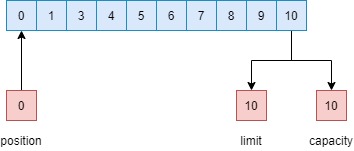
Buffer 的常用方法
| 方法 | 描述 |
|---|---|
| Buffer clear() | 清空缓冲区并返回对缓冲区的引用 |
| Buffer flip() | 将缓冲区的界限设置为当前位置,并将当前位置充值为 0 |
| int capacity() | 返回 Buffer 的 capacity 大小 |
| boolean hasRemaining() | 判断缓冲区中是否还有元素 |
| int limit() | 返回 Buffer 的界限(limit) 的位置 |
| Buffer limit(int n) | 将设置缓冲区界限为 n, 并返回一个具有新 limit 的缓冲区对象 |
| Buffer mark() | 对缓冲区设置标记 |
| int position() | 返回缓冲区的当前位置 position |
| Buffer position(int n) | 将设置缓冲区的当前位置为 n , 并返回修改后的 Buffer 对象 |
| int remaining() | 返回 position 和 limit 之间的元素个数 |
| Buffer reset() | 将位置 position 转到以前设置的 mark 所在的位置 |
| Buffer rewind() | 将位置设为为 0, 取消设置的 mark |
缓冲区的数据操作
- 获取Buffer中的数据
get() :读取单个字节
get(byte[] dst):批量读取多个字节到 dst 中
get(int index):读取指定索引位置的字节(不会移动 position)
- 放入数据到Buffer中
put(byte b):将给定单个字节写入缓冲区的当前位置
put(byte[] src):将 src 中的字节写入缓冲区的当前位置
put(int index, byte b):将指定字节写入缓冲区的索引位置(不会移动 position)
直接与非直接缓冲区
- 字节缓冲区要么是直接的,要么是非直接的。如果为直接字节缓冲区,则Java虚拟机会尽最大努力直接在此缓冲区上执行本机 I/O 操作。也就是说,在每次调用基础操作系统的一个本机 I/O 操作之前(或之后), 虚拟机都会尽量避免将缓冲区的内容复制到中间缓冲区中(或从中间缓冲区中复制内容)。
- 直接字节缓冲区可以通过调用此类的allocateDirect()工厂方法来创建。此方法返回的缓冲区进行分配和取消 分配所需成本通常高于非直接缓冲区。直接缓冲区的内容可以驻留在常规的垃圾回收堆之外,因此,它们对 应用程序的内存需求量造成的影响可能并不明显。所以,建议将直接缓冲区主要分配给那些易受基础系统的 本机 I/O 操作影响的大型、持久的缓冲区。一般情况下,最好仅在直接缓冲区能在程序性能方面带来明显好 处时分配它们。
- 直接字节缓冲区还可以通过FileChannel的map()方法将文件区域直接映射到内存中来创建。该方法返回 MappedByteBuffer 。Java 平台的实现有助于通过 JNI 从本机代码创建直接字节缓冲区。如果以上这些缓冲区中的某个缓冲区实例指的是不可访问的内存区域,则试图访问该区域不会更改该缓冲区的内容,并且将会在访问期间或稍后的某个时间导致抛出不确定的异常。
- 字节缓冲区是直接缓冲区还是非直接缓冲区可通过调用其isDirect()方法来确定。提供此方法是为了能够在 性能关键型代码中执行显式缓冲区管理。
- 非直接缓冲区

- 直接缓冲区
通道(Channel)
介绍
通道(Channel):由 java.nio.channels 包定义 的。Channel 表示 IO 源与目标打开的连接。 Channel 类似于传统的“流”。只不过 Channel 本身不能直接访问数据,Channel 只能与 Buffer 进行交互。
- 传统流
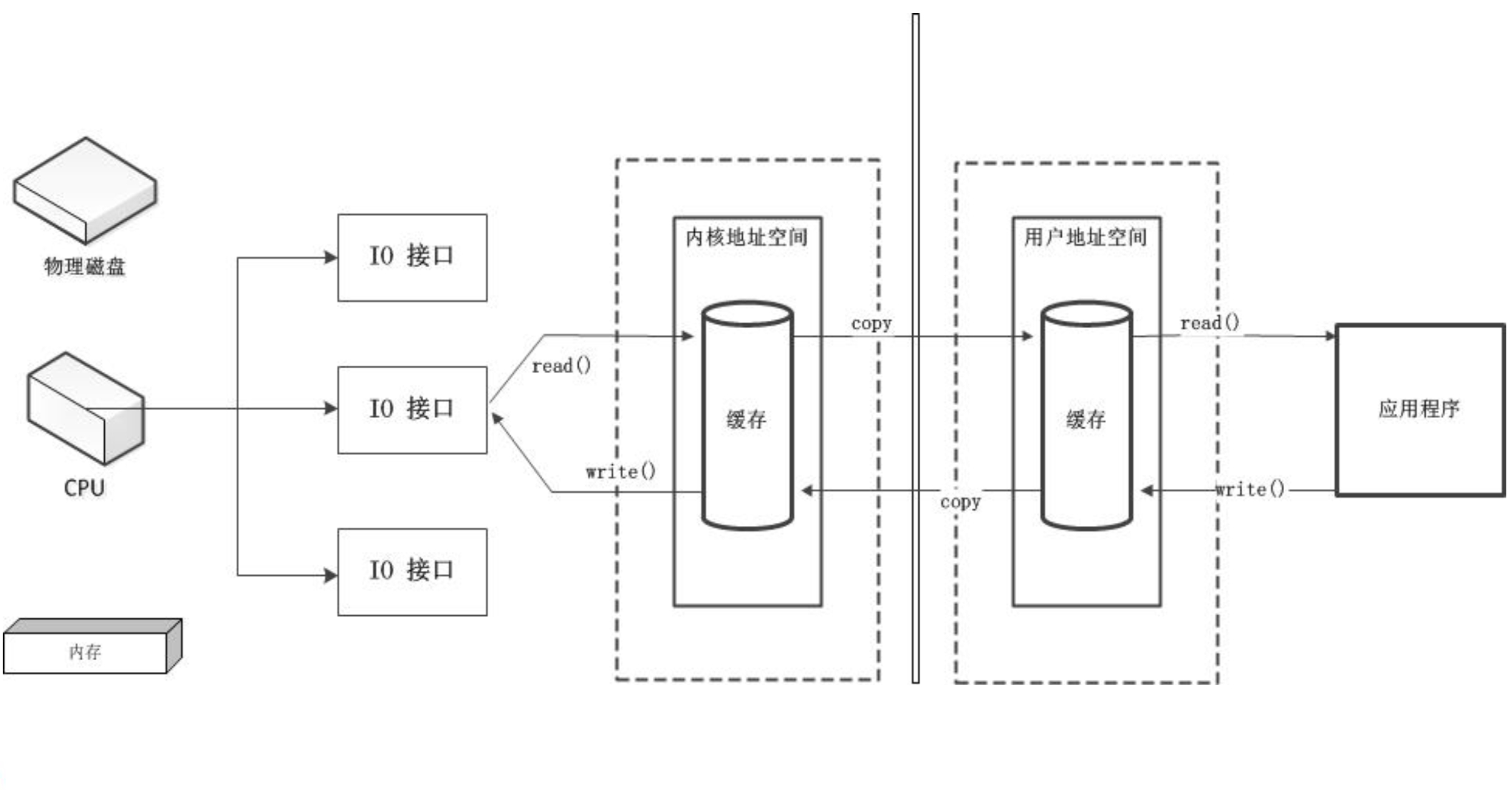
- Channel
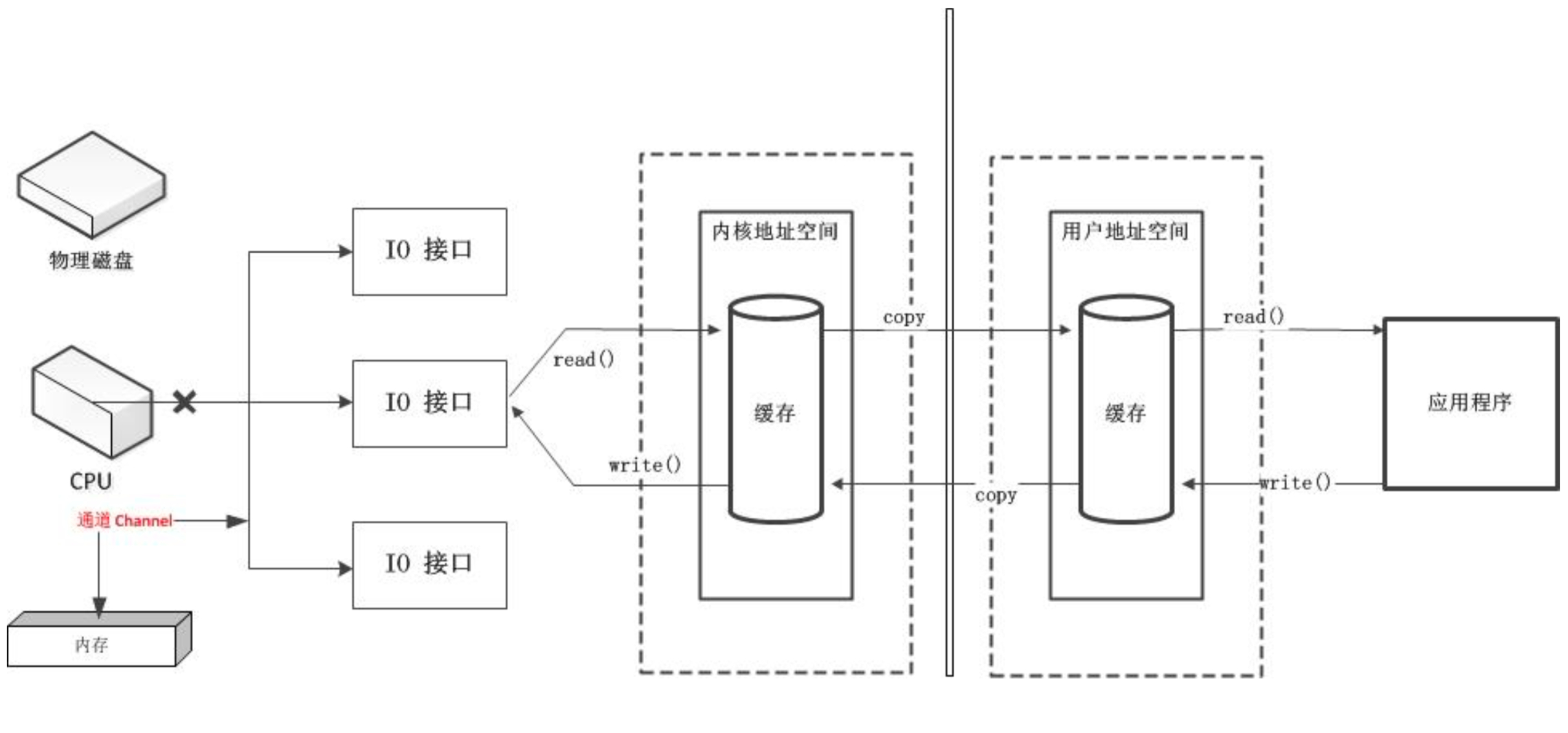
Java 为 Channel 接口提供的最主要实现类如下:
- FileChannel:用于读取、写入、映射和操作文件的通道。
- DatagramChannel:通过 UDP 读写网络中的数据通道。
- SocketChannel:通过 TCP 读写网络中的数据。
ServerSocketChannel:可以监听新进来的 TCP 连接,对每一个新进来的连接都会创建一个 SocketChannel。
获取通道
获取通道的一种方式是对支持通道的对象调用 getChannel() 方法。支持通道的类如下:
FileInputStream
- FileOutputStream
- RandomAccessFile
- DatagramSocket
- Socket
- ServerSocket
获取通道的其他方式是使用 Files 类的静态方法 newByteChannel() 获 取字节通道。或者通过通道的静态方法 open() 打开并返回指定通道。
通道的数据传输
将 Buffer 中数据写入 Channel
// 将Buffer 中的数据写入Channel中int bytesWritten = channel2.write(bufs);
从 Channel 读取数据到 Buffer
// 从Channel 读取数据到Buffer中int bytesRead = inChannel.read(buf)
分散(Scatter)和聚集(Gather
分散读取(Scattering Reads)是指从 Channel 中读取的数据“分散”到多个 Buffer 中。
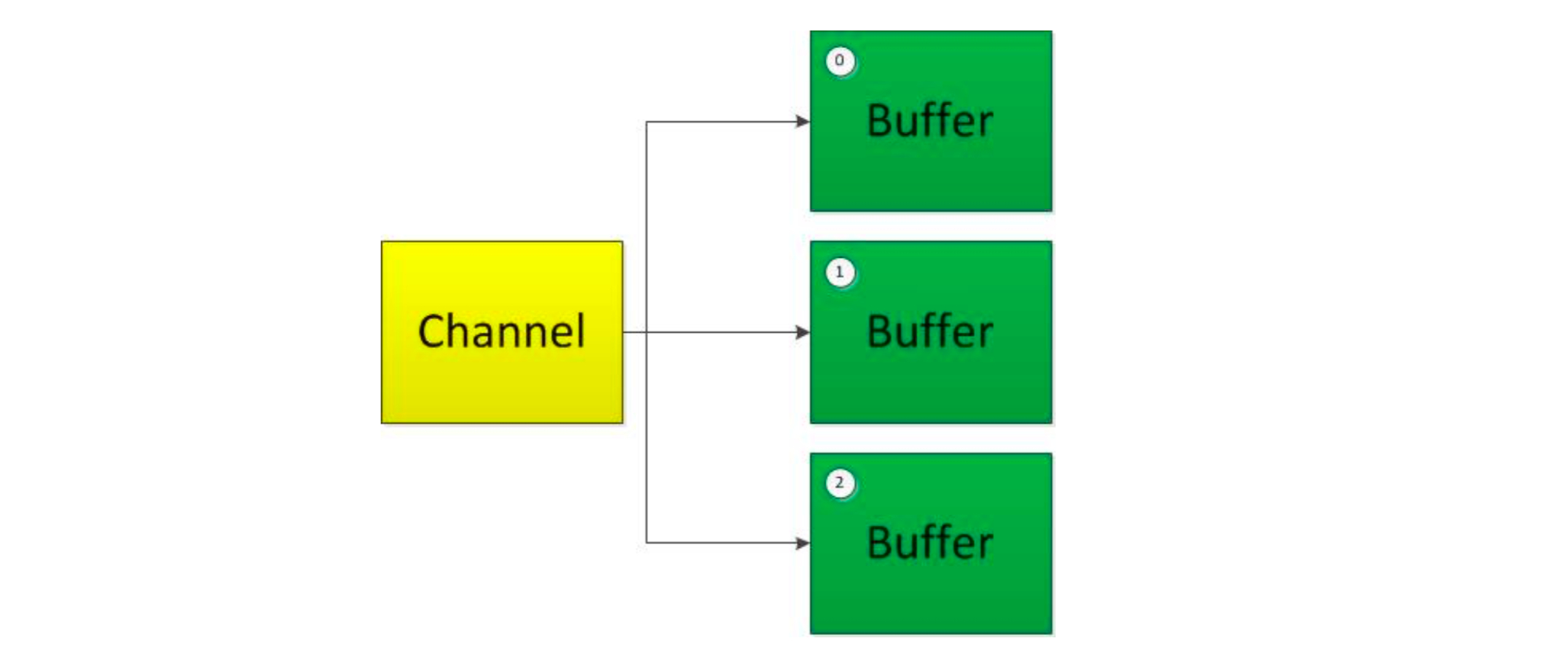
注意:按照缓冲区的顺序,从 Channel 中读取的数据依次将 Buffer 填满。
- 聚集写入(Gathering Writes)是指将多个 Buffer 中的数据“聚集” 到 Channel。

注意:按照缓冲区的顺序,写入 position 和 limit 之间的数据到 Channel 。
transferFrom()
将数据从源通道传输到其他 Channel 中
FileChannel inChannel = FileChannel.open(Paths.get("d:/1.mkv"), StandardOpenOption.READ);FileChannel outChannel = FileChannel.open(Paths.get("d:/2.mkv"), StandardOpenOption.WRITE, StandardOpenOption.READ, StandardOpenOption.CREATE);outChannel.transferFrom(inChannel, 0, inChannel.size());inChannel.close();outChannel.close();
transferTo()
将数据从源通道传输到其他 Channel 中
FileChannel inChannel = FileChannel.open(Paths.get("d:/1.mkv"), StandardOpenOption.READ);FileChannel outChannel = FileChannel.open(Paths.get("d:/2.mkv"), StandardOpenOption.WRITE, StandardOpenOption.READ, StandardOpenOption.CREATE);inChannel.transferTo(0, inChannel.size(), outChannel);inChannel.close();outChannel.close();
FileChannel 常用方法
| 方法 | 描述 |
|---|---|
| int read(ByteBuffer dst) | 从 Channel 中读取数据到 ByteBuffer |
| long read(ByteBuffer[] dsts) | 将 Channel 中的数据“分散”到 ByteBuffer[] |
| int write(ByteBuffer src) | 将 ByteBuffer 中的数据写入到 Channel |
| long write(ByteBuffer[] srcs) | 将 ByteBuffer[] 中的数据“聚集”到 Channel |
| long position() | 返回此通道的文件位置 |
| FileChannel position(long p) | 设置此通道的文件位置 |
| long size() | 返回此通道的文件的当前大小 |
| FileChannel truncate(long s) | 将此通道的文件截取为给定大小 |
| void force(boolean metaData) | 强制将所有对此通道的文件更新写入到存储设备中 |
NIO 的非阻塞式网络通信
阻塞与非阻塞
- 传统的 IO 流都是阻塞式的。也就是说,当一个线程调用 read() 或 write() 时,该线程被阻塞,直到有一些数据被读取或写入,该线程在此期间不能执行其他任务。因此,在完成网络通信进行 IO 操作时,由于线程会阻塞,所以服务器端必须为每个客户端都提供一个独立的线程进行处理, 当服务器端需要处理大量客户端时,性能急剧下降。
Java NIO 是非阻塞模式的。当线程从某通道进行读写数据时,若没有数 据可用时,该线程可以进行其他任务。线程通常将非阻塞 IO 的空闲时间用于在其他通道上执行 IO 操作,所以单独的线程可以管理多个输入 和输出通道。因此,NIO 可以让服务器端使用一个或有限几个线程来同 时处理连接到服务器端的所有客户端。
选择器(Selector)
选择器(Selector) 是 SelectableChannle 对象的多路复用器,Selector 可 以同时监控多个 SelectableChannel 的 IO 状况,也就是说,利用 Selector 可使一个单独的线程管理多个 Channel。Selector 是非阻塞 IO 的核心
- SelectableChannle 的结构如下图
选择器(Selector)的应用
创建 Selector :通过调用 Selector.open() 方法创建一个 Selector。
// 创建选择器Selector selector = Selector.open();
向选择器注册通道:SelectableChannel.register(Selector sel,int ops)
//1. 获取通道SocketChannel sChannel = SocketChannel.open(new InetSocketAddress("127.0.0.1", 9898));//2. 切换非阻塞模式sChannel.configureBlocking(false);//3. 绑定连接sChannel.bind(new InetSocketAddress(9898));//4. 获取选择器Selector selector = Selector.open();//5. 将通道注册到选择器上, 并且指定“监听接收事件”sChannel.register(selector, SelectionKey.OP_ACCEPT);
选择器(Selector)的应用
当调用 register(Selector sel, int ops) 将通道注册选择器时,选择器对通道的监听事件,需要通过第二个参数 ops 指定。
- 可以监听的事件类型(可使用 SelectionKey 的四个常量表示)
- 读 : SelectionKey.OP_READ (1)
- 写 : SelectionKey.OP_WRITE (4)
- 连接:SelectionKey.OP_CONNECT (8)
- 接收 : SelectionKey.OP_ACCEPT (16)
若注册时不止监听一个事件,则可以使用“位或”操作符连接。
// 注册多个"监听事件"int interestSet = SelectionKey.OP_READ | SelectionKey.OP_ACCEPT;
SelectionKey:表示 SelectableChannel 和 Selector 之间的注册关系。每次向选择器注册通道时就会选择一个事件(选择键)。选择键包含两个表示为整数值的操作集。操作集的每一位都表示该键的通道所支持的一类可选择操作 | 方法 | 描述 | | —- | —- | | int interestOps() | 获取感兴趣事件集合 | | int readyOps() | 获取通道已经准备就绪的操作的集合 | | SelectableChannel channel() | 获取注册通道 | | Selector selector() | 返回选择器 | | boolean isReadable() | 检测 Channal 中读事件是否就绪 | | boolean isWritable() | 检测 Channal 中写事件是否就绪 | | boolean isConnectable() | 检测 Channel 中连接是否就绪 | | boolean isAcceptable() | 检测 Channel 中接收是否就绪 |
Selector 的常用方法
| 方法 | 描述 |
|---|---|
| Set keys() | 所有的 SelectionKey 集合。代表注册在该Selector上的Channel |
| selectedKeys() | 被选择的 SelectionKey 集合。返回此Selector的已选择键集 |
| int select() | 监控所有注册的Channel,当它们中间有需要处理的 IO 操作时, 该方法返回,并将对应得的 SelectionKey 加入被选择的 SelectionKey 集合中,该方法返回这些 Channel 的数量。 |
| int select(long timeout) | 可以设置超时时长的 select() 操作 |
| int selectNow() | 执行一个立即返回的 select() 操作,该方法不会阻塞线程 |
| Selector wakeup() | 使一个还未返回的 select() 方法立即返回 |
| void close() | 关闭该选择器 |
SocketChannel
- Java NIO中的SocketChannel是一个连接到TCP网 络套接字的通道。
- 操作步骤:
- 打开 SocketChannel
- 读写数据
- 关闭 SocketChannel
- Java NIO中的 ServerSocketChannel 是一个可以 监听新进来的TCP连接的通道,就像标准IO中 的ServerSocket一样。
Java NIO 通道基础代码例子
package com.atguigu.nio;import java.io.FileInputStream;import java.io.FileOutputStream;import java.io.IOException;import java.io.RandomAccessFile;import java.nio.ByteBuffer;import java.nio.CharBuffer;import java.nio.MappedByteBuffer;import java.nio.channels.FileChannel;import java.nio.channels.FileChannel.MapMode;import java.nio.charset.CharacterCodingException;import java.nio.charset.Charset;import java.nio.charset.CharsetDecoder;import java.nio.charset.CharsetEncoder;import java.nio.file.Paths;import java.nio.file.StandardOpenOption;import java.util.Map;import java.util.Map.Entry;import java.util.Set;import org.junit.Test;/** 一、通道(Channel):用于源节点与目标节点的连接。在 Java NIO 中负责缓冲区中数据的传输。Channel 本身不存储数据,因此需要配合缓冲区进行传输。** 二、通道的主要实现类* java.nio.channels.Channel 接口:* |--FileChannel* |--SocketChannel* |--ServerSocketChannel* |--DatagramChannel** 三、获取通道* 1. Java 针对支持通道的类提供了 getChannel() 方法* 本地 IO:* FileInputStream/FileOutputStream* RandomAccessFile** 网络IO:* Socket* ServerSocket* DatagramSocket** 2. 在 JDK 1.7 中的 NIO.2 针对各个通道提供了静态方法 open()* 3. 在 JDK 1.7 中的 NIO.2 的 Files 工具类的 newByteChannel()** 四、通道之间的数据传输* transferFrom()* transferTo()** 五、分散(Scatter)与聚集(Gather)* 分散读取(Scattering Reads):将通道中的数据分散到多个缓冲区中* 聚集写入(Gathering Writes):将多个缓冲区中的数据聚集到通道中** 六、字符集:Charset* 编码:字符串 -> 字节数组* 解码:字节数组 -> 字符串**/public class TestChannel {//字符集@Testpublic void test6() throws IOException{Charset cs1 = Charset.forName("GBK");//获取编码器CharsetEncoder ce = cs1.newEncoder();//获取解码器CharsetDecoder cd = cs1.newDecoder();CharBuffer cBuf = CharBuffer.allocate(1024);cBuf.put("尚硅谷威武!");cBuf.flip();//编码ByteBuffer bBuf = ce.encode(cBuf);for (int i = 0; i < 12; i++) {System.out.println(bBuf.get());}//解码bBuf.flip();CharBuffer cBuf2 = cd.decode(bBuf);System.out.println(cBuf2.toString());System.out.println("------------------------------------------------------");Charset cs2 = Charset.forName("GBK");bBuf.flip();CharBuffer cBuf3 = cs2.decode(bBuf);System.out.println(cBuf3.toString());}@Testpublic void test5(){Map<String, Charset> map = Charset.availableCharsets();Set<Entry<String, Charset>> set = map.entrySet();for (Entry<String, Charset> entry : set) {System.out.println(entry.getKey() + "=" + entry.getValue());}}//分散和聚集@Testpublic void test4() throws IOException{RandomAccessFile raf1 = new RandomAccessFile("1.txt", "rw");//1. 获取通道FileChannel channel1 = raf1.getChannel();//2. 分配指定大小的缓冲区ByteBuffer buf1 = ByteBuffer.allocate(100);ByteBuffer buf2 = ByteBuffer.allocate(1024);//3. 分散读取ByteBuffer[] bufs = {buf1, buf2};channel1.read(bufs);for (ByteBuffer byteBuffer : bufs) {byteBuffer.flip();}System.out.println(new String(bufs[0].array(), 0, bufs[0].limit()));System.out.println("-----------------");System.out.println(new String(bufs[1].array(), 0, bufs[1].limit()));//4. 聚集写入RandomAccessFile raf2 = new RandomAccessFile("2.txt", "rw");FileChannel channel2 = raf2.getChannel();channel2.write(bufs);}//通道之间的数据传输(直接缓冲区)@Testpublic void test3() throws IOException{FileChannel inChannel = FileChannel.open(Paths.get("d:/1.mkv"), StandardOpenOption.READ);FileChannel outChannel = FileChannel.open(Paths.get("d:/2.mkv"), StandardOpenOption.WRITE, StandardOpenOption.READ, StandardOpenOption.CREATE);inChannel.transferTo(0, inChannel.size(), outChannel);// outChannel.transferFrom(inChannel, 0, inChannel.size());inChannel.close();outChannel.close();}//使用直接缓冲区完成文件的复制(内存映射文件)@Testpublic void test2() throws IOException{//2127-1902-1777long start = System.currentTimeMillis();FileChannel inChannel = FileChannel.open(Paths.get("d:/1.mkv"), StandardOpenOption.READ);FileChannel outChannel = FileChannel.open(Paths.get("d:/2.mkv"), StandardOpenOption.WRITE, StandardOpenOption.READ, StandardOpenOption.CREATE);//内存映射文件MappedByteBuffer inMappedBuf = inChannel.map(MapMode.READ_ONLY, 0, inChannel.size());MappedByteBuffer outMappedBuf = outChannel.map(MapMode.READ_WRITE, 0, inChannel.size());//直接对缓冲区进行数据的读写操作byte[] dst = new byte[inMappedBuf.limit()];inMappedBuf.get(dst);outMappedBuf.put(dst);inChannel.close();outChannel.close();long end = System.currentTimeMillis();System.out.println("耗费时间为:" + (end - start));}//利用通道完成文件的复制(非直接缓冲区)@Testpublic void test1(){//10874-10953long start = System.currentTimeMillis();FileInputStream fis = null;FileOutputStream fos = null;//①获取通道FileChannel inChannel = null;FileChannel outChannel = null;try {fis = new FileInputStream("d:/1.mkv");fos = new FileOutputStream("d:/2.mkv");inChannel = fis.getChannel();outChannel = fos.getChannel();//②分配指定大小的缓冲区ByteBuffer buf = ByteBuffer.allocate(1024);//③将通道中的数据存入缓冲区中while(inChannel.read(buf) != -1){buf.flip(); //切换读取数据的模式//④将缓冲区中的数据写入通道中outChannel.write(buf);buf.clear(); //清空缓冲区}} catch (IOException e) {e.printStackTrace();} finally {if(outChannel != null){try {outChannel.close();} catch (IOException e) {e.printStackTrace();}}if(inChannel != null){try {inChannel.close();} catch (IOException e) {e.printStackTrace();}}if(fos != null){try {fos.close();} catch (IOException e) {e.printStackTrace();}}if(fis != null){try {fis.close();} catch (IOException e) {e.printStackTrace();}}}long end = System.currentTimeMillis();System.out.println("耗费时间为:" + (end - start));}}
Java NIO 缓冲区代码例子
package com.atguigu.nio;import java.nio.ByteBuffer;import org.junit.Test;/** 一、缓冲区(Buffer):在 Java NIO 中负责数据的存取。缓冲区就是数组。用于存储不同数据类型的数据** 根据数据类型不同(boolean 除外),提供了相应类型的缓冲区:* ByteBuffer* CharBuffer* ShortBuffer* IntBuffer* LongBuffer* FloatBuffer* DoubleBuffer** 上述缓冲区的管理方式几乎一致,通过 allocate() 获取缓冲区** 二、缓冲区存取数据的两个核心方法:* put() : 存入数据到缓冲区中* get() : 获取缓冲区中的数据** 三、缓冲区中的四个核心属性:* capacity : 容量,表示缓冲区中最大存储数据的容量。一旦声明不能改变。* limit : 界限,表示缓冲区中可以操作数据的大小。(limit 后数据不能进行读写)* position : 位置,表示缓冲区中正在操作数据的位置。** mark : 标记,表示记录当前 position 的位置。可以通过 reset() 恢复到 mark 的位置** 0 <= mark <= position <= limit <= capacity** 四、直接缓冲区与非直接缓冲区:* 非直接缓冲区:通过 allocate() 方法分配缓冲区,将缓冲区建立在 JVM 的内存中* 直接缓冲区:通过 allocateDirect() 方法分配直接缓冲区,将缓冲区建立在物理内存中。可以提高效率*/public class TestBuffer {@Testpublic void test3(){//分配直接缓冲区ByteBuffer buf = ByteBuffer.allocateDirect(1024);System.out.println(buf.isDirect());}@Testpublic void test2(){String str = "abcde";ByteBuffer buf = ByteBuffer.allocate(1024);buf.put(str.getBytes());buf.flip();byte[] dst = new byte[buf.limit()];buf.get(dst, 0, 2);System.out.println(new String(dst, 0, 2));System.out.println(buf.position());//mark() : 标记buf.mark();buf.get(dst, 2, 2);System.out.println(new String(dst, 2, 2));System.out.println(buf.position());//reset() : 恢复到 mark 的位置buf.reset();System.out.println(buf.position());//判断缓冲区中是否还有剩余数据if(buf.hasRemaining()){//获取缓冲区中可以操作的数量System.out.println(buf.remaining());}}@Testpublic void test1(){String str = "abcde";//1. 分配一个指定大小的缓冲区ByteBuffer buf = ByteBuffer.allocate(1024);System.out.println("-----------------allocate()----------------");System.out.println(buf.position());System.out.println(buf.limit());System.out.println(buf.capacity());//2. 利用 put() 存入数据到缓冲区中buf.put(str.getBytes());System.out.println("-----------------put()----------------");System.out.println(buf.position());System.out.println(buf.limit());System.out.println(buf.capacity());//3. 切换读取数据模式buf.flip();System.out.println("-----------------flip()----------------");System.out.println(buf.position());System.out.println(buf.limit());System.out.println(buf.capacity());//4. 利用 get() 读取缓冲区中的数据byte[] dst = new byte[buf.limit()];buf.get(dst);System.out.println(new String(dst, 0, dst.length));System.out.println("-----------------get()----------------");System.out.println(buf.position());System.out.println(buf.limit());System.out.println(buf.capacity());//5. rewind() : 可重复读buf.rewind();System.out.println("-----------------rewind()----------------");System.out.println(buf.position());System.out.println(buf.limit());System.out.println(buf.capacity());//6. clear() : 清空缓冲区. 但是缓冲区中的数据依然存在,但是处于“被遗忘”状态buf.clear();System.out.println("-----------------clear()----------------");System.out.println(buf.position());System.out.println(buf.limit());System.out.println(buf.capacity());System.out.println((char)buf.get());}}
Java NIO 非阻塞模式通过网络传输文件代码例子
package com.atguigu.nio;import java.io.IOException;import java.net.InetSocketAddress;import java.nio.ByteBuffer;import java.nio.channels.SelectionKey;import java.nio.channels.Selector;import java.nio.channels.ServerSocketChannel;import java.nio.channels.SocketChannel;import java.util.Date;import java.util.Iterator;import java.util.Scanner;import org.junit.Test;/** 一、使用 NIO 完成网络通信的三个核心:** 1. 通道(Channel):负责连接** java.nio.channels.Channel 接口:* |--SelectableChannel* |--SocketChannel* |--ServerSocketChannel* |--DatagramChannel** |--Pipe.SinkChannel* |--Pipe.SourceChannel** 2. 缓冲区(Buffer):负责数据的存取** 3. 选择器(Selector):是 SelectableChannel 的多路复用器。用于监控 SelectableChannel 的 IO 状况**/public class TestNonBlockingNIO {//客户端@Testpublic void client() throws IOException{//1. 获取通道SocketChannel sChannel = SocketChannel.open(new InetSocketAddress("127.0.0.1", 9898));//2. 切换非阻塞模式sChannel.configureBlocking(false);//3. 分配指定大小的缓冲区ByteBuffer buf = ByteBuffer.allocate(1024);//4. 发送数据给服务端Scanner scan = new Scanner(System.in);while(scan.hasNext()){String str = scan.next();buf.put((new Date().toString() + "\n" + str).getBytes());buf.flip();sChannel.write(buf);buf.clear();}//5. 关闭通道sChannel.close();}//服务端@Testpublic void server() throws IOException{//1. 获取通道ServerSocketChannel ssChannel = ServerSocketChannel.open();//2. 切换非阻塞模式ssChannel.configureBlocking(false);//3. 绑定连接ssChannel.bind(new InetSocketAddress(9898));//4. 获取选择器Selector selector = Selector.open();//5. 将通道注册到选择器上, 并且指定“监听接收事件”ssChannel.register(selector, SelectionKey.OP_ACCEPT);//6. 轮询式的获取选择器上已经“准备就绪”的事件while(selector.select() > 0){//7. 获取当前选择器中所有注册的“选择键(已就绪的监听事件)”Iterator<SelectionKey> it = selector.selectedKeys().iterator();while(it.hasNext()){//8. 获取准备“就绪”的是事件SelectionKey sk = it.next();//9. 判断具体是什么事件准备就绪if(sk.isAcceptable()){//10. 若“接收就绪”,获取客户端连接SocketChannel sChannel = ssChannel.accept();//11. 切换非阻塞模式sChannel.configureBlocking(false);//12. 将该通道注册到选择器上sChannel.register(selector, SelectionKey.OP_READ);}else if(sk.isReadable()){//13. 获取当前选择器上“读就绪”状态的通道SocketChannel sChannel = (SocketChannel) sk.channel();//14. 读取数据ByteBuffer buf = ByteBuffer.allocate(1024);int len = 0;while((len = sChannel.read(buf)) > 0 ){buf.flip();System.out.println(new String(buf.array(), 0, len));buf.clear();}}//15. 取消选择键 SelectionKeyit.remove();}}}}
Java NIO 阻塞模式通过网络传输文件代码例子
package com.atguigu.nio;import java.io.IOException;import java.net.InetSocketAddress;import java.nio.ByteBuffer;import java.nio.channels.FileChannel;import java.nio.channels.ServerSocketChannel;import java.nio.channels.SocketChannel;import java.nio.file.Paths;import java.nio.file.StandardOpenOption;import org.junit.Test;/** 一、使用 NIO 完成网络通信的三个核心:** 1. 通道(Channel):负责连接** java.nio.channels.Channel 接口:* |--SelectableChannel* |--SocketChannel* |--ServerSocketChannel* |--DatagramChannel** |--Pipe.SinkChannel* |--Pipe.SourceChannel** 2. 缓冲区(Buffer):负责数据的存取** 3. 选择器(Selector):是 SelectableChannel 的多路复用器。用于监控 SelectableChannel 的 IO 状况**/public class TestBlockingNIO2 {//客户端@Testpublic void client() throws IOException{SocketChannel sChannel = SocketChannel.open(new InetSocketAddress("127.0.0.1", 9898));FileChannel inChannel = FileChannel.open(Paths.get("1.jpg"), StandardOpenOption.READ);ByteBuffer buf = ByteBuffer.allocate(1024);while(inChannel.read(buf) != -1){buf.flip();sChannel.write(buf);buf.clear();}sChannel.shutdownOutput();//接收服务端的反馈int len = 0;while((len = sChannel.read(buf)) != -1){buf.flip();System.out.println(new String(buf.array(), 0, len));buf.clear();}inChannel.close();sChannel.close();}//服务端@Testpublic void server() throws IOException{ServerSocketChannel ssChannel = ServerSocketChannel.open();FileChannel outChannel = FileChannel.open(Paths.get("2.jpg"), StandardOpenOption.WRITE, StandardOpenOption.CREATE);ssChannel.bind(new InetSocketAddress(9898));SocketChannel sChannel = ssChannel.accept();ByteBuffer buf = ByteBuffer.allocate(1024);while(sChannel.read(buf) != -1){buf.flip();outChannel.write(buf);buf.clear();}//发送反馈给客户端buf.put("服务端接收数据成功".getBytes());buf.flip();sChannel.write(buf);sChannel.close();outChannel.close();ssChannel.close();}}
